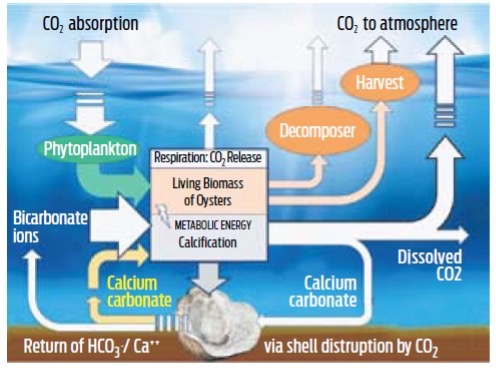A new study has highlighted significant limitations in current methods of removing carbon dioxide from the ocean, suggesting that more scientific rigor is needed to improve these techniques for effective climate action. Unlike terrestrial approaches such as afforestation, marine carbon removal methods like shellfish cultivation, seaweed farming, and mangrove restoration require further development, according to researchers.
The study, conducted by scientists from the University of East Anglia (UEA), the University of Tasmania’s Institute for Marine and Antarctic Studies, Centre National Recherche Scientifique, and the Institute for Sustainable Development and International Relations, examines the climatic effectiveness of four nature-based techniques using marine biological processes. These include shellfish cultivation, seaweed farming, coastal blue carbon (restoration of seagrass, salt marsh, and mangrove forests), and increasing whale populations through “re-wilding.”
The researchers found that scaling up these methods involves other ocean processes that could negate the effectiveness of the proposed carbon dioxide removal (CDR) approaches. They concluded that while these activities offer non-climatic benefits, they cannot significantly contribute to CDR and might ultimately prove to be “dead ends” in terms of meaningful climate mitigation.
The study, published in Environmental Research Letters, emphasizes the need for a better understanding of basic ocean processes, which is currently hindering progress in marine CDR. The commercialization of some of these approaches is deemed “premature and misguided,” the paper states.
To limit global warming to less than 2°C, both emissions reductions and effective CDR strategies are essential. The researchers argue that new ocean-based CDR methods are being proposed without sufficient checks and balances, posing risks as they gain interest from both the scientific community and the private sector.
“Proponents of these methods have an incomplete or incorrect grasp not only of how the ocean carbon cycle functions but also of the massive upscaling needed to provide significant climatic benefits,” said co-author Dr. David Williamson, honorary associate professor at UEA’s School of Environmental Sciences.
Lead author Prof. Philip Boyd, of the University of Tasmania’s Institute for Marine and Antarctic Studies, highlighted the need for better communication of the basic criteria for CDR viability using marine processes. He stressed that safety, durability, verifiability, and scalability should guide R&D funding and policy decisions.
The authors also raised concerns over the “opportunity costs” — the resources allocated to these approaches that could be better invested in reducing emissions and developing other CDR methods, both land and ocean-based, that are more likely to be safe, sustainable, durable, verifiable, and scalable.
Dr. Williamson concluded, “We believe that using these four nature-based approaches for carbon offsets is more likely to represent greenwashing, rather than these methods becoming the ‘climate heroes’ that some people are claiming.”

